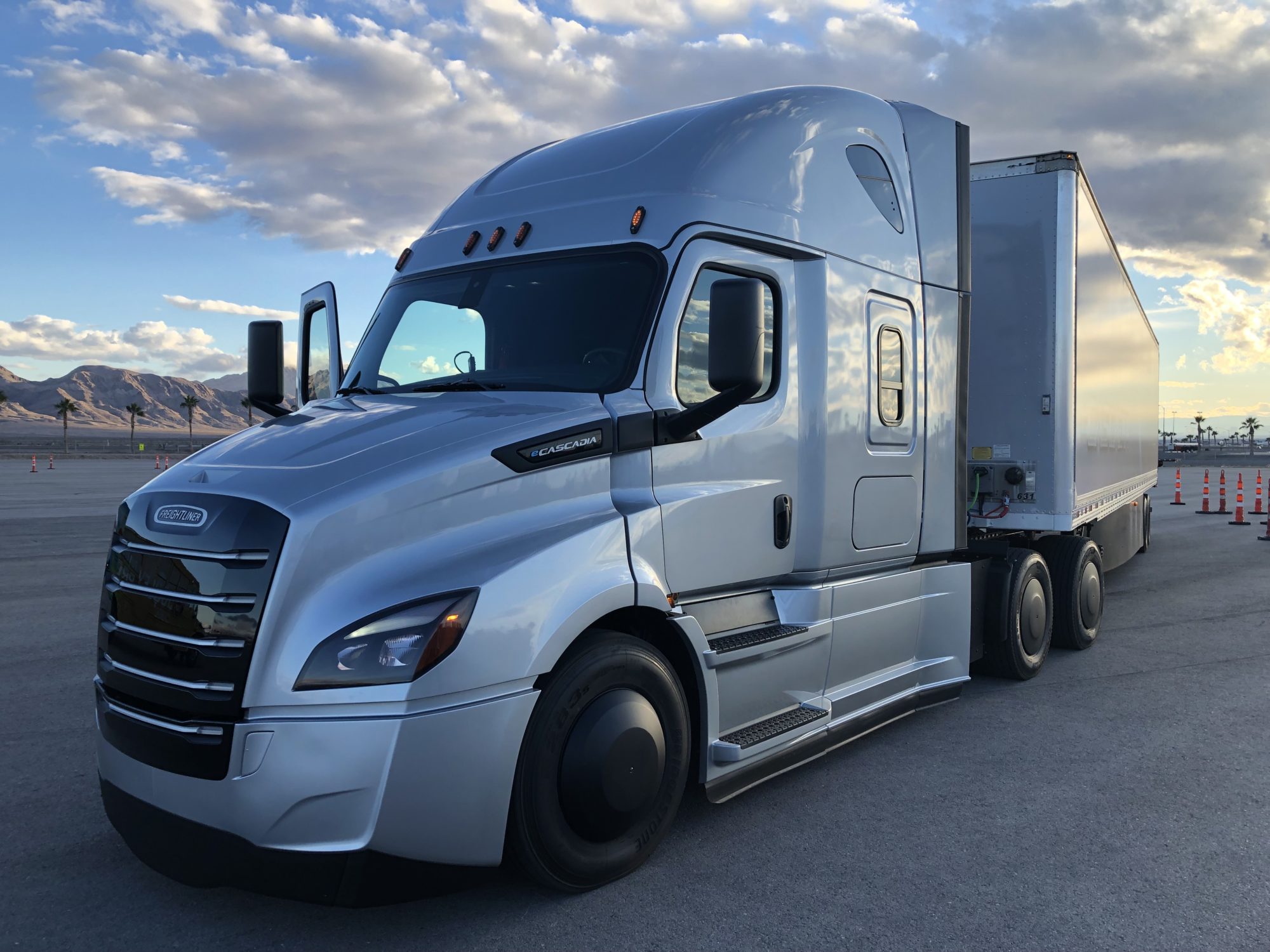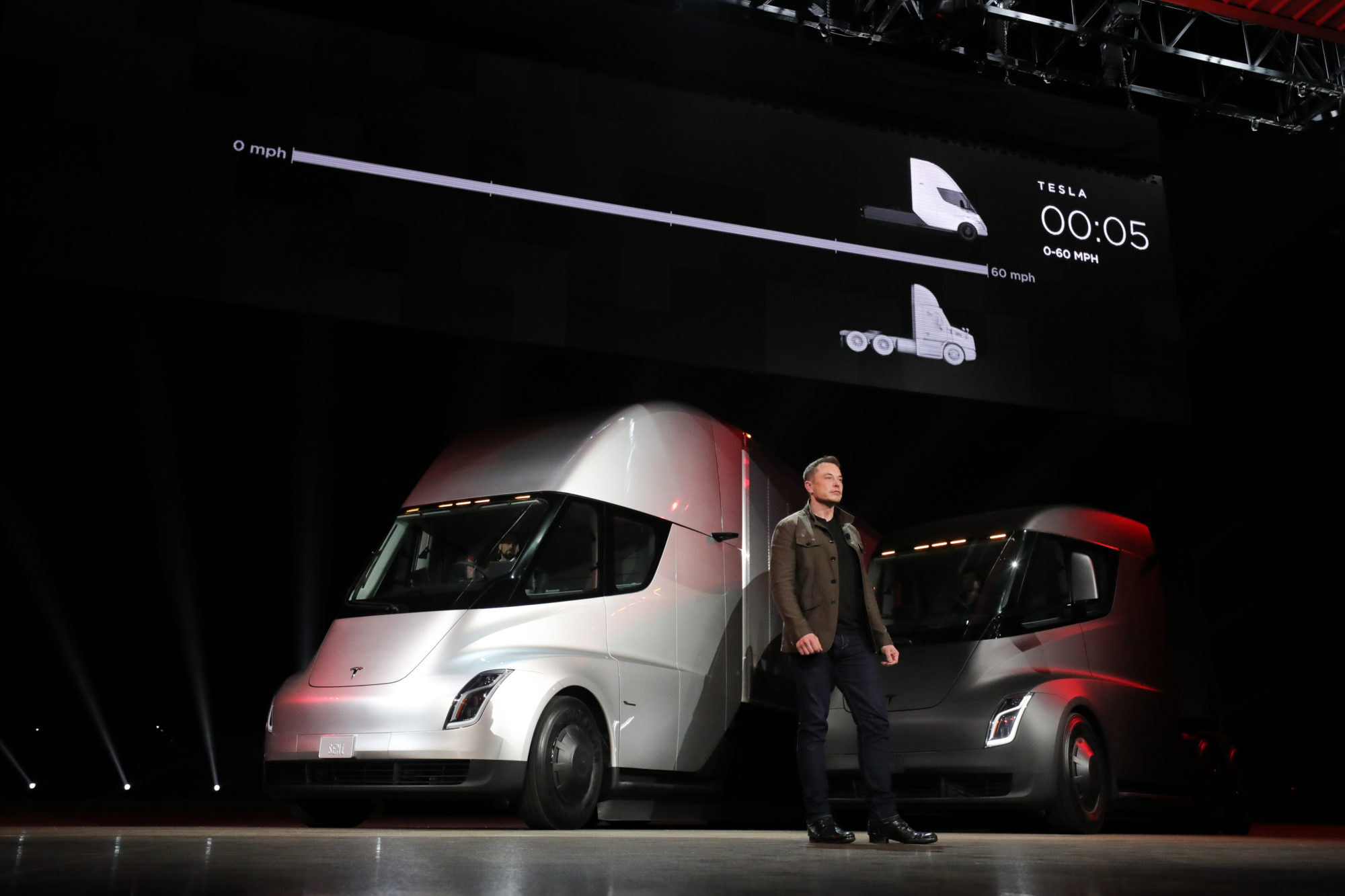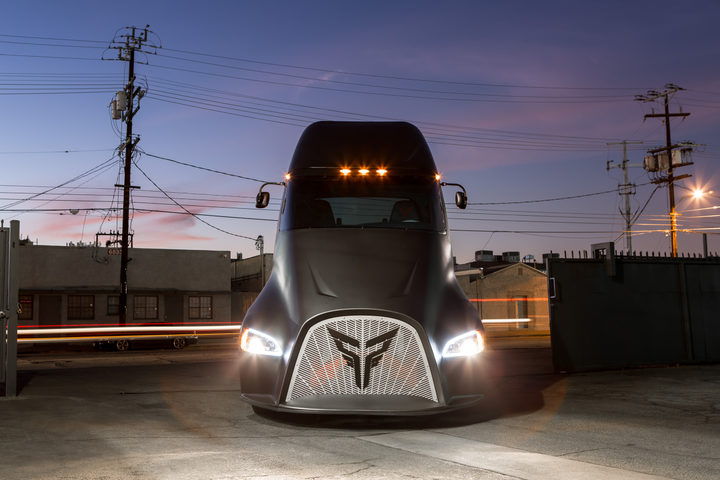The race to develop electric trucks is on

LAS VEGAS, Nev. — There is no escaping the sound of engines at the Las Vegas Motor Speedway. It seems to come from every direction, a steady hum of cars on the oval punctuated by the roar of fighter jets stationed at nearby Nellis Air Force Base. There’s clearly no hope of being heard whenever the jets are overhead. Freightliner personnel simply stop mid-sentence and laugh it off until the roar subsides.
When it comes time to open the door to a speedway parking lot, however, the Freightliner team offers a different sort of warning about the sounds that people can expect from a demonstration of Daimler-made trucks. These models can sneak up on you, they stress. Be aware of your surroundings.
The eCascadia and eM2 are the first prototypes destined for the Freightliner Electric Innovation Fleet, among the earliest battery-electric trucks to haul freight in North America. The little noise that they generate comes in the form of exhausting air brakes and the scrunch of tires against cement.
Call them the sounds of silence — and you’ll be hearing more about them in the months to come.

Prepare for an electric year
Established and emerging manufacturers alike are racing to bring some form of battery-electric vehicles or fuel cells to North America, with several introducing all-important test fleets during 2019.
Early production efforts have focused on models like the Fuso eCanter and Chanje panel van for good reason. The North American Council for Freight Efficiency (NACFE) found that the natural applications for battery-electric vehicles still include medium-duty trucks that run one shift per day and sit still long enough for recharging. For that matter, trucks of this size also tend to cube out before grossing out, meaning that hefty batteries are a lesser concern.
But larger models are clearly taking shape.
Freightliner will divide the first 30 eM2 and eCascadia trucks between Penske Truck Leasing and NFI National Freight. Volvo Trucks North America, meanwhile, will have electrified VNR tractors on the road in 2019 as well. And Mack Trucks has already announced plans to test an electrified LR waste truck with New York City’s Department of Transportation.
Further reading:
The ABCs of electric trucks, from BYD to VNR
The list grew longer yet at this year’s Consumer Electronics Show. Kenworth and Toyota, which had individually been testing hydrogen fuel cells, announced they are joining forces to build 10 vehicles that will be tested by Toyota’s logistics operation, selected drayage haulers, and UPS.
Peterbilt added a medium-duty Model 220EV to test models already including a Model 520EV and Model 579EV, exploring possibilities in refuse, regional haul, and urban delivery applications. It expects to have more than 30 electric vehicles running this year, with a food and beverage hauler collecting the first of the newest trucks.
As for Navistar, it has promised to bring a medium-duty electric powertrain to North America in the same timeframe, drawing on expertise from partners and shareholders at Traton Group, formerly Volkswagen Truck and Bus.
Established manufacturers are not the only ones in the race, either. Ryder recently ordered 1,000 battery-electric Chanje panel vans to be put in service in the next two years. Nikola has reportedly secured more than US $13 billion in pre-orders for its hydrogen-electric trucks, with production of the Nikola 2 model to begin in 2021. Loblaw has tested a Build Your Dreams (BYD) drayage truck in Vancouver, while UPS is running field trials of a Class 6 Thor vehicle around Los Angeles.
Then there’s Elon Musk. The Tesla CEO promised one of North America’s first Class 8 electric trucks, unveiling the prototype of his Tesla Semi as early as December 2017. Production of that truck was to begin this year as well, although some reports suggest the date has been pushed to 2020. (Tesla didn’t return requests for comment.)
“Tesla shook up the whole industry and made it go a little bit faster,” Volvo Trucks North America president Peter Voorhoeve said late last year, referring to the way Musk’s widely publicized announcement may have accelerated plans by other manufacturers.
Established manufacturers believe they have a vital edge in the race to market, though.
“Everybody can build one or two trucks. Everybody can build 10,” says Andreas Jurtzka, senior e-mobility lead for Daimler Trucks North America. The question is who can produce 1,000 units that are not only practical but will be reliable for several years.

Who will use electric trucks?
Today’s power densities limit the opportunities for battery-electric vehicles in longhaul service. The batteries required to deliver the necessary ranges are simply too heavy to be practical. But early test models are showing a widespread focus on the routes traveled by refuse vehicles, regional drayage haulers, and local pickup and delivery applications.
“At Peterbilt we believe those three applications are going to have the most immediate and near-term payback in terms of an ROI for our customers,” says Peterbilt general manager Jason Skoog.
Granted, there are still plenty of unknowns. “Nobody has a clue right now what the TCO [total cost of ownership] looks like,” Jurtzka says. It’s one of the reasons why a new eConsulting service will be central to any of Daimler’s future electric vehicle rollouts. This will explore available trucks, assess routes, analyze economic feasibility, provide financing, deploy charging infrastructure, support maintenance and operations, manage the fleet, and deal with the vehicle’s end of life – even finding a use for aging batteries. The manufacturer has established a customer council to explore the technologies, too.
But when releasing a report on electric vehicle technologies, North American Council for Freight Efficiency (NACFE) executive director Mike Roeth observed that the cost of using electric trucks in shorter, mild duty cycles is drawing closer to the cost associated with traditional combustion engines.
“What we knew about batteries 1-1/2 years ago is not valid today,” adds Magnus Koeck, Volvo Trucks North America’s vice-president – marketing and brand management, referring to ongoing advancements.
Lessons are clearly being learned along the way, and many of the prototypes hitting the road this year are based on proven concepts. Volvo’s VNR will rely on a propulsion system and batteries found in the European FE Electric. Kenworth and Toyota, meanwhile, are drawing on the fuel cells found in Toyota Mirai cars – similar to the Ballard Power Systems fuel cells that Kenworth used in the prototype of its Zero Emissions Cargo Transport (ZECT) truck.
But for every proven concept there’s an unknown challenge, which is why the first models are emerging as test fleets. Creating an electric truck involves far more than pulling out engines, aftertreatment systems, and fuel tanks, after all. Even traditional equipment including the belt-driven accessories like HVAC systems and compressors will require electric motors of their own.
Then there’s the ever-present demand for cooling. “There’s a lot of piping that goes on, and cooling every different part of the truck differently,” says Jurtzka.
“One of the lessons we learned with our ZECT [Zero Emission Cargo Transport] truck is we have to heat the batteries when they get really cold,” adds Brian Lindgren, Kenworth’s director of research and development. “We have to heat them up so we can apply energy batteries in a hurry when we need to make a shift. For example, the fuel cell wants to generate energy all the time. You have to stop that for a minute when you make a shift. And if you can’t put it into the battery, what do you do with it?”
Fit and finish becomes particularly important as well. In the silence of the prototype Freightliner vehicles running around a parking lot, it was easy to become focused on sounds like the “tick-tick” of a fan, the whir a steering pump, and a cabinet that wasn’t properly latched. There was no running engine to help mask sounds like those.
Plugging into infrastructure
To compound matters, the rollouts involve more than trucks alone. Any of these vehicles will present new “refueling” requirements, whether they come through a plug-in charger or a hydrogen fuel island. And some utility providers tell Daimler that they need two years to establish requested charging infrastructure.
There isn’t even a consensus about what the connectors will look like or where it should be mounted. For now, Freightliner has adopted the European Combined Charging System (CCS2) standard plug and will mount it on the driver’s side of the eM2. And it continues to participate with the CharIn initiative that’s looking to establish common plugs and communication standards.
There can even be differences across an individual brand.
“In each of these trucks, we have different levels of charging stations,” said Joshua Goldman, vice-president of business development at TransPower, referring to Peterbilt. “We can detune the onboard 70-kw four-hour charger on the 579 to a 12-hour charger if that’s the time they have, or we can upgrade to DC fast charge and charge in as little as one hour with upwards of 125 to 350 kw using DC fast-charge technology developed for cars [but] at a higher voltage needed for the heavy-duty powertrains.”
For that matter, will plugs even be needed in the future? Volvo Group’s venture capital subsidiary just invested in Momentum Dynamics, which is exploring high-power wireless charging, which would allow trucks to tap into 300 kW of charging power as they pass over the system.
Just roll and go.

The ‘Goldilocks’ area
In most cases, Canada will have to wait before seeing test fleets of its own. Most manufacturers are focusing their efforts in and around California, leveraging grants available through the California Air Resources Board (CARB).
Those funds are available as the Port of Los Angeles targets a goal of banning anything but emission-free trucks by 2035. About 16,000 diesel models currently serve the ports of Los Angeles and Long Beach.
Millions of related dollars are being invested by the South Coast Air Quality Management District (SCAQMD), an air pollution control agency that covers Orange County and urban areas of Los Angeles, Riverside, and San Bernardino counties. The area historically has the worst air quality in the U.S. because of natural geographic and atmospheric conditions, coupled with a dense population.
The “clean” nature of electric vehicles is ultimately decided by the source of the electricity. For example, net pollutants will be lower if the energy comes from a renewable source like a wind farm rather than an aging coal facility. But California is moving forward to establish the electric vehicles with confidence that cleaner electricity sources are coming. Eventually.
Lindgren also describes California as a “Goldilocks area” for such research at the moment. “It’s not too hot. It’s not too cold if you’re on the coast,” he says. “If you can stay in the 50 Fahrenheit to 100 Fahrenheit [10 to 38 Celsius], that’s pretty easy to handle.”
In the meantime, there’s also the ever-present challenge of purchase prices, and all of these trucks are more expensive to buy than their diesel-powered counterparts. But things are changing.
Says Voorhoeve: “There’s a lot of scientists trying to predict where the cross point of diesel and electric is, and it’s not that far away.”
Further reading: How do electric motors work in electric trucks?
[envira-gallery id=”143196″]
Have your say
This is a moderated forum. Comments will no longer be published unless they are accompanied by a first and last name and a verifiable email address. (Today's Trucking will not publish or share the email address.) Profane language and content deemed to be libelous, racist, or threatening in nature will not be published under any circumstances.